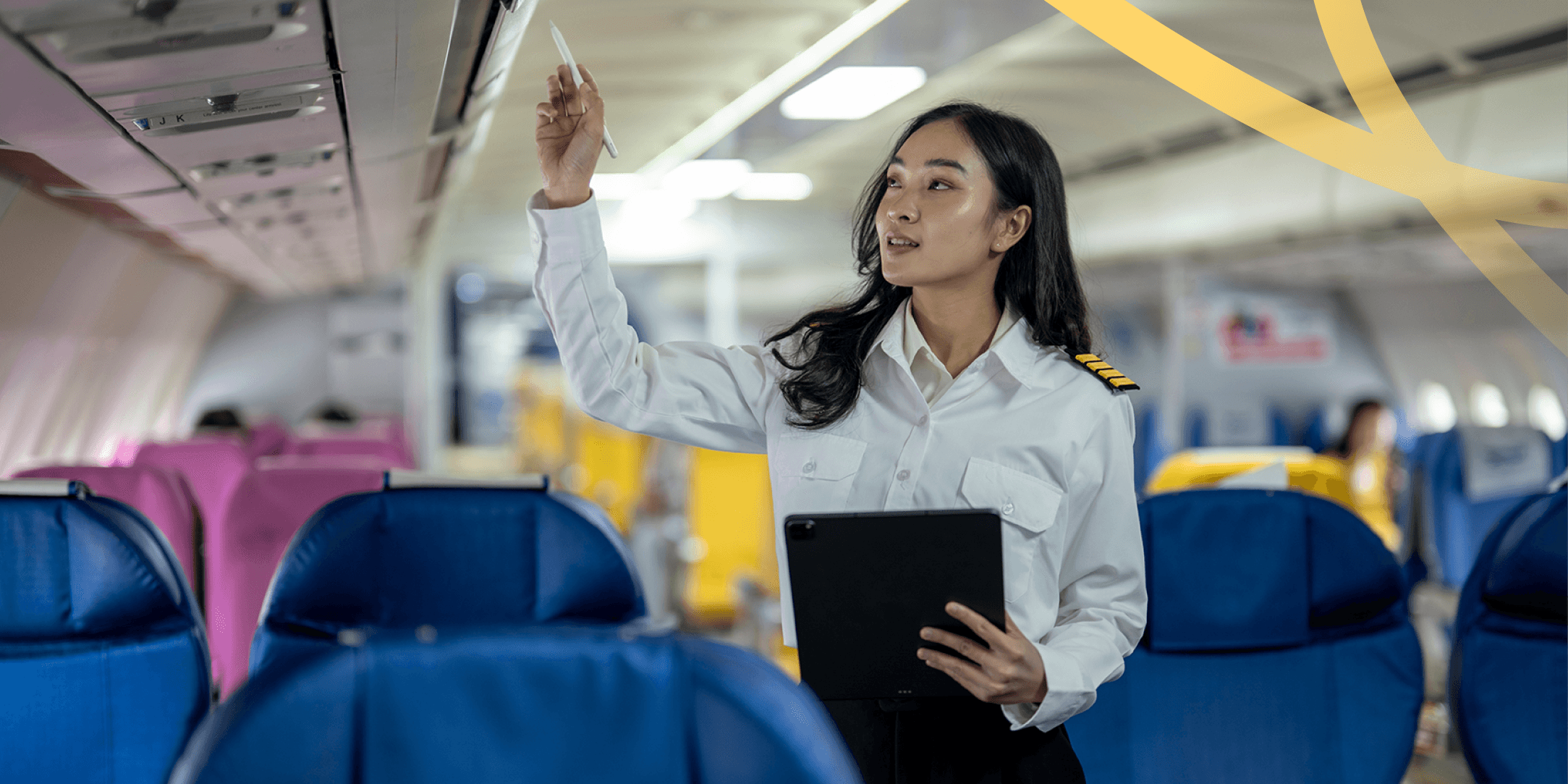Learn from 5,000+ comms leaders on exec buy-in, engagement, and the ROI puzzle.
How To Close the Engagement Gap for Airline Employees

Caitlin Kirwan
External Contributor - Internal Comms & Engagement Expert
July 4 2024

Airlines face more than their fair share of turbulence. Excuse the pun. They operate in a heavily regulated industry that’s often fighting an uphill battle when it comes to things like sustainability, safety, and staff shortages. Margins are tight, so they’re particularly vulnerable to economic downturns and are at the mercy of other external factors like weather and, ehm… pandemics.
But another significant challenge for airlines is engaging and retaining the employees who spend their days in the air and dealing with passengers on the ground.
On average, around 85% of an airline’s workforce is made up of the frontline staff we come across when we fly, including pilots, cabin crew, gate agents, and check-in teams. And data consistently shows that these kinds of frontline workers are less engaged than their desk-based colleagues.
While the engagement gap between frontline and desk-based employees is evident within almost all industries, the consequences of disengagement are substantially more serious within organizations where employees’ daily performance directly impacts everything from customer satisfaction to the likelihood of a serious accident.
Let’s start by taking a look at the airline engagement gap in more detail.
An employee engagement gap in airlines
Earlier this year, US flight attendants caused widespread disruption at major airports by protesting as part of new contract negotiations. In Europe, strikes by various employee groups within Lufthansa impacted their earnings by a whopping €350 million in the first quarter of 2024. And a pilot strike in Ireland caused Aer Lingus to cancel a significant number of flights this June, affecting over 15,000 customers.
So, it’s no secret that relations between an airline’s employees and leadership aren’t always sunshine and roses. This kind of industrial action not only takes a financial toll, but is also incredibly damaging to brand reputation.
There’s often a lack of trust in management, leading to frontline employees feeling undervalued, disconnected, and underrepresented at the top table. So it doesn’t come as much of a surprise that airlines are so heavily unionized, with employees joining external associations that negotiate with their employer for things like better conditions, pay, and benefits.
Looking specifically at pilots, it’s estimated that 98% in the US and 94% in Canada belong to a union. The story is much the same in the UK, with 85% of all pilots belonging to the British Airline Pilots’ Association (BALPA) and a large proportion of cabin crew also joining a union.
Union membership is certainly not a bad thing. In fact, Gallup’s State of the Global Workplace 2024 report found that employees who feel as though their labor rights are being protected evaluate their overall lives more positively. However, high union membership could suggest a lack of stability and trust in the organization, which highlights a need for airlines to improve communication with their frontline workers and increase leadership transparency.
The airline engagement gap becomes apparent when you consider that 85% of airline employees are frontline workers who are statistically less likely to be engaged than their desk-based colleagues. Despite this, many engagement strategies still fail to meet the needs of employees who are not based in an office or at a desk.
And when frontline workers are disengaged, they are less motivated to perform at the best of their abilities, which leads to worse customer service, reduced productivity levels, missed deadlines, and generally a lower quality of work. Within an airline, the consequences of this kind of disengagement might not always directly lead to labor strikes, but can have serious implications like flight delays, dissatisfied customers, and even safety-related incidents.
Whatever way you look at it, different strategies are needed to build connection, trust, and, ultimately, close the engagement gap between frontline and office-based airline employees.
4 ways for engaging airline employees on the front line
We know that an engaged workforce leads to better business results.
Research published earlier this summer found that the most engaged teams achieve 23% higher profitability than the least engaged teams. This leap in profitability mainly comes down to lower employee turnover, higher standard of customer service, and better quality outputs.
Ultimately, it’s about using effective communication to establish a base of trust and stability, helping employees feel more connected to their airline.
So, here are four impactful ways for airlines to improve the engagement of their frontline workers.
1. Prioritize transparent leader communications
One of the best ways to build organizational pride and increase trust in management is to level up leader communications. Airlines need to ensure their CEO and C-Suite leaders are visible, authentic, and transparent.
It’s important to prioritize building a positive internal brand for senior leaders within the airline to both promote trust and align the organization with a shared purpose. But it takes time. One recorded All Hands and a ‘New Year’ CEO email certainly isn’t going to cut the mustard.
Senior leader communications need to be frequent, honest, and accessible for all employees – whether they work on the ground or in the aircraft. This means using communication channels that target all different audience groups, staying consistent with content scheduling, and keeping two-way communication channels open to make sure leaders can keep their fingers on the pulse.
2. Amplify the voices of frontline aircrew
To build a loyal and engaged workforce, airlines need to proactively facilitate two-way communication between frontline staff and the rest of the organization. It’s important that teams based in airports and aircraft feel connected to leadership, global crew members, and other colleagues across various departments within the airline.
All airline employees need to be given ongoing opportunities to speak up and make their voices heard, particularly those working on the front line. Amplifying their voices and ensuring they are truly listened to by leadership is one of the best ways to improve relations and build trust.
The employees in the air are the ones who know the organization best. They interact with customers every day, navigate the airline’s operations first-hand, and feel the brunt of delays and maintenance issues. Yet it’s still common for frontline aircrew to feel as though they are not listened to, understood, or appreciated by management.
3. Make your communication channels mobile-optimized
Not having the right workplace tools is one of the leading causes of frustration and disengagement for frontline workers. But a third say they don’t have access to the right technology to do their jobs effectively, and I think it’s fair to say that many employee experience platforms (EXPs) and legacy intranets are still a bit… rubbish…when accessed on a mobile device.
As you can imagine, this doesn’t bode well for frontline airline employees who can only access their company’s EXP on a mobile device.
70% of Gen Z employees – who represent a rapidly growing percentage of many airlines’ frontline crews – even say they would leave their job for access to better technology. So in an industry where clear, real-time communication is key to smooth operations, things have to change.
And while many intranets and employee experience platforms are now becoming mobile-enabled, it’s not always good enough. A mobile-enabled EXP usually reorganizes and reformats existing content to work for a mobile device, rather than providing a mobile-optimized experience that has been specifically designed with remote access in mind. Workvivo is helping turn the tide by offering an intuitive mobile-first solution that truly meets the needs of frontline workers in airlines.
4. Help frontline managers communicate effectively
70% of the variance in engagement is determined solely by the line manager. In other words, the way a manager operates and, importantly – communicates – makes the difference between an engaged or a disengaged team.
The most successful airlines support their line managers and team leaders to communicate more effectively, providing training, resources, and technology. Research shows us that employees who work in companies with bad management practices are around 60% more likely to be stressed than those in companies with good management practices. And this is only exacerbated in the high-pressured (literally) environments that frontline airline employees work in every day.
Conversely, employees with managers who communicate well are almost three times as likely to be engaged than those with managers who do not. So how can we best help frontline managers in airlines communicate effectively?
Here are my top tips:
- Produce high-quality content for managers to cascade to their teams
- Provide communication training
- Prioritize ease and convenience
- Partner with line managers to get regular feedback
Click here to read Workvivo’s Guide To Supporting Line Manager Communications.
Having the right technology is also critical for airline team leaders and managers to be able to communicate effectively with their teams. Workvivo helps bridge gaps between management and crew with real-time updates and feedback channels to maintain dialogue, address any grievances, and reduce the likelihood of disruptions.
PS, Last year, we spoke to frontline crew and internal communication leaders within multiple airlines to understand the best ways to engage and communicate with airline employees. Read the full article here!